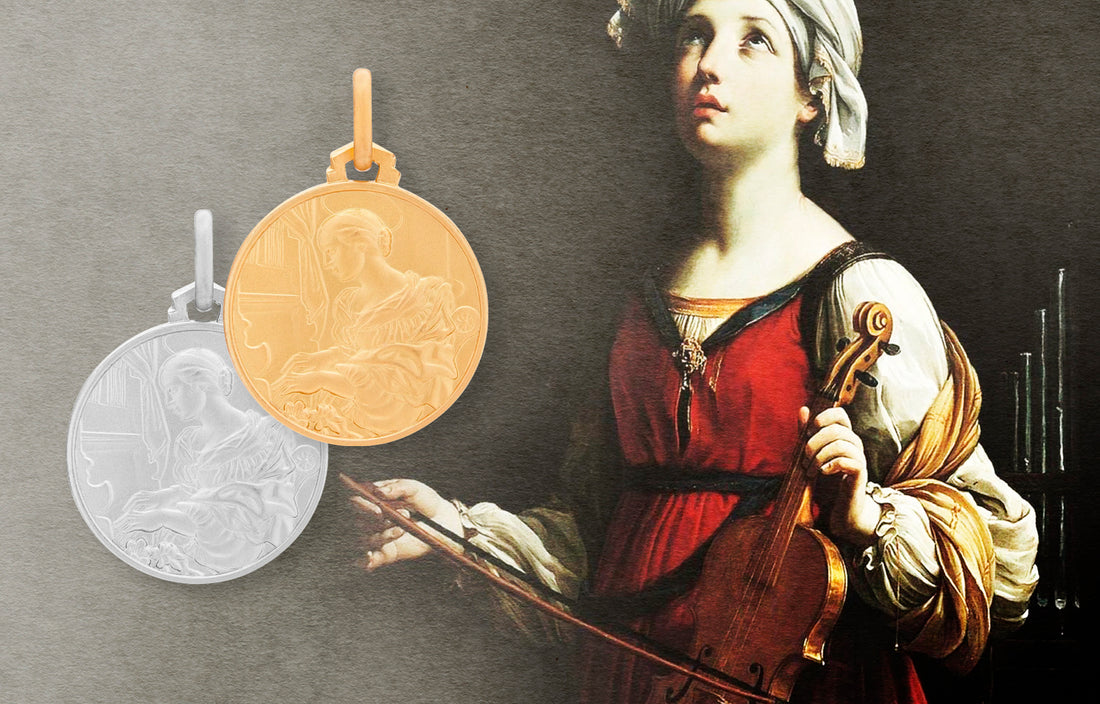In the annals of Catholic lore, St. Cecilia emerges as a formidable presence, hailed as the matron saint of vocalists, melody, and minstrels. Her existence, consecrated to Christ, and her unyielding fortitude in confronting martyrdom, render her a paragon of unwavering faith and self-sacrifice.
Cecilia's genesis unfolds in the tapestry of 3rd-century Rome, amidst opulence and nobility, within the crucible of Christian suppression. Despite the inhospitable milieu, she clandestinely embraced the Christian doctrine, consecrating herself to Christ as her divine consort, diligently observing penance and abstention.
The Sacrifice for Faith
Compelled into matrimony with Valerian, a Roman aristocrat steeped in pagan rituals, Cecilia, against her volition, intoned a hymn lauding the Almighty during their nuptial revelry, laying bare her profound faith. Post the matrimonial rites, preceding Valerian's endeavor to consummate the union, Cecilia unveiled her Christian allegiance and the sacred pledge of chastity to her celestial spouse. Undaunted, she apprised Valerian of an angelic sentinel, commissioned by God to guard her purity, poised to forcefully repel any transgressor. Cecilia granted Valerian's plea to witness the celestial guardian under one stipulation – he must seek Pope Urban I, undergo catechetical tutelage, and undergo baptism.
Valerian sought the bishop, received the sacrament of baptism, and upon his reunion with Cecilia, beheld not only the celestial guardian shielding her but also witnessed the celestial emissary adorning him with a dual diadem of alabaster lilies, emblematic of purity, and crimson roses, foreshadowing her impending martyrdom. Enthralled by this celestial spectacle, Valerian fully embraced the Christian faith, venerating his wife's vow of chastity. In addition, he converted his sibling Tiburtius, and unitedly, they immersed themselves in the subversive Christian enclave. This drew the scrutiny of the Prefect, who, confronted with their steadfast refusal to proffer oblations to the Roman deity Jupiter, decreed their decapitation.
The Martyrdom of St. Cecilia
In the immediate aftermath, a decree consigned Cecilia to an endeavor of asphyxiation within her private thermal sanctuary. However, this Machiavellian scheme faltered, and she emerged unscathed. Consequently, the Prefect, resolute in his pursuit, decreed her decapitation. The designated soldier, tasked with this grim duty, made three fervent attempts, adhering to Roman legal constraints that forbade a fourth endeavor. Despite the relentless and violent blows to the nape of her neck, Cecilia persisted in survival, relegated to a protracted and agonizing demise. This ill-fated period endured for three additional days, during which the Christian assemblage congregated within her domicile. She dispensed her entire fortune to the indigent and bestowed her abode upon the pontiff for consecration into a Christian sanctum.
Burial and the Basilica of St. Cecilia
Following St. Cecilia's demise, her resting place found sanctuary in the Catacombs of San Callisto, while her dwelling underwent a metamorphosis into a sacred edifice commissioned by Pope Urban – recognized today as the Basilica of Saint Cecilia in Trastevere. Several centuries later, in the year 821, Pope Paschal I deemed it fitting to relocate her mortal remains from the catacomb to the ecclesiastical structure originally erected by Pope Urban, subsequently expanded upon.
In preparation for the Jubilee of 1600, during the course of refurbishments, Cardinal Paolo Emilio Sfrondati oversaw the exhumation of St. Cecilia's remains. To his astonishment, her corporeal form exhibited a miraculous preservation. Presently, her sepulcher resides beneath the principal altar, adorned with a marble sarcophagus crafted by the artisan Stefano Maderno. This masterpiece faithfully captures the artist's observations in 1599: St. Cecilia draped in a resplendent ensemble of silk and gold, her visage inclined toward the earth. Three digits of her dexterous hand extend skyward in homage to the Holy Trinity.
Harmony and Imagery: St. Cecilia's Artistic Affiliation
The entwining of St. Cecilia with music found its roots in the latter stages of the Middle Ages, spurred by a misinterpretation of a Latin chant. The era witnessed a flourishing of Cecilian iconography, reaching its zenith in Raphael's "Ecstasy of Saint Cecilia," portraying the martyr accompanied by a portable organ and musical instruments at her feet. This musical connection bestowed upon her the veneration as the matron saint of minstrels and vocalists.
Observances and Customs: Revering Music and Devotion
Annually, on November 22, the Catholic Church commemorates the feast of St. Cecilia. Across the globe, musicians, vocalists, and music aficionados unite to pay homage to the patron saint of melodies. Celebrations manifest diversely, spanning from musical concerts and performances to dedicated masses extolling sacred harmonies. In certain cultures, the day doubles as an occasion to advocate for musical and artistic education.
St. Cecilia in Artistry and Pop Culture
St. Cecilia's influence transcends ecclesiastical boundaries, permeating the realms of artistry and popular culture. Myriad paintings, sculptures, and creative expressions have been conceived to honor her venerable persona. Furthermore, the appellation "Santa Cecilia" frequently graces churches, auditoriums, and musical establishments.
Significance of the St. Cecilia Medal
Crafted with precision, the St. Cecilia medal encapsulates the saint in poignant poses. Typically adorned with symbols echoing her narrative and role as the guardian of music, the medal may feature depictions such as an organ, musical instruments, or the digits of her hands signifying her unwavering faith even amid martyrdom.
The lineage of the St. Cecilia medal intertwines with the devotion to the saint, harkening back to ancient times, with the Basilica of Santa Cecilia in Trastevere perpetuating her name and spiritual legacy. Beyond a mere sacred adornment, the medal becomes a conduit through which the faithful articulate their faith, seeking the safeguard and guidance of St. Cecilia in their musical pursuits.
Wearing it transcends a mere act of donning sacred jewelry; it symbolizes a profound connection to the storied history and spirituality enshrined within this saint. It stands as a testament to faith and gratitude towards the one who, across the centuries, remains a fount of inspiration and protection for those who dedicate their lives to the world of music.
